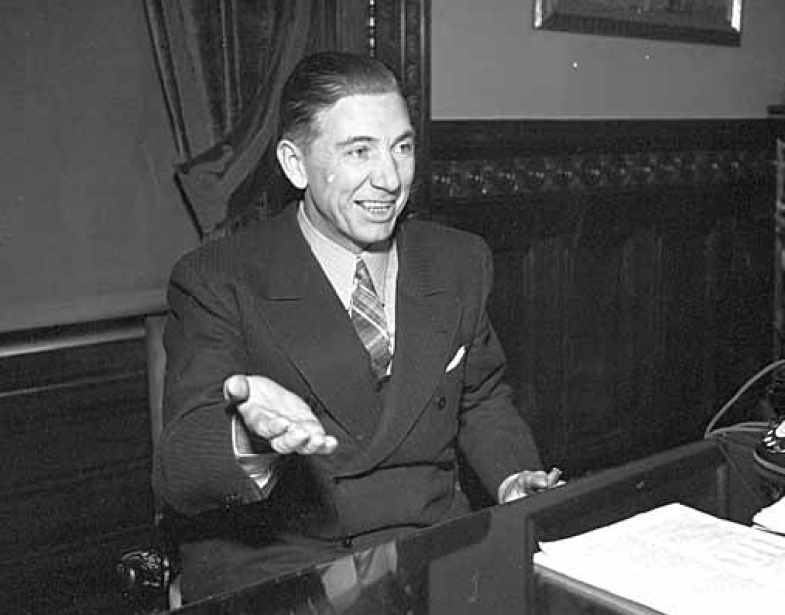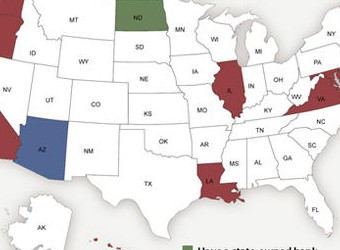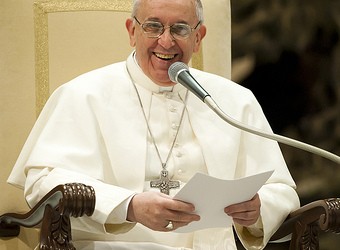I recently attended Common Bound, a Boston conference sponsored by the New Economy Coalition, a network of organizations committed to a more just and sustainable economy. The gathering included progressive luminaries and a wide range of thoughtful presentations. It was thankfully diverse, in gender, racial background and age. Indeed, most of the staff of the New Economy Coalition is under thirty, a sign that Millennials have gone beyond Occupy in seeking practical alternatives to our present failed economic order. But what seemed missing at the conference was any effort to look back and see what lessons from history might be relevant to our current situation.
This impatience with history is not new. Although the founding document of the influential Students for a Democratic Society (SDS), the 1962 Port Huron Statement, acknowledged its antecedents, much of the New Left was dismissive of the past. This October, I’ll attend the 50th anniversary of Berkeley’s Free Speech Movement, where, as a college freshman, I got a baptism in politics that helped make me an activist for all of my days. Much of the New Left that grew from that movement was openly dismissive of tradition. As Minneapolis historian Tom O’Connell, himself a New Left veteran, put it in an essay for On The Commons:
Back in those days we had an unfortunate slogan, “Never trust anybody over thirty.” We were trying to construct a new world from scratch without realizing that in the not very distant past, there was an indigenous radical tradition flourishing right down the road. The discovery of Minnesota’s Farmer-Labor movement and the Cooperative Commonwealth vision that animated it gave me grounding and inspiration.
In my view, “the Cooperative Commonwealth vision” deserves exhumation from the cemetery of forgotten history and offers a sharper expression of what “the New Economy” actually wants to achieve. As a vision of the society we hope to build, it can inspire and clarify. Terms currently in vogue to describe an alternative to the present are either unnecessarily vague—the term New Economy could equally describe a libertarian free-market vision—or already carry negative associations for many Americans.
For example, “Socialism,” despite its local successes—former Mayor (and now Senator) Bernie Sanders in Vermont, recently elected city council member Kshama Sawant in Seattle—remains an anathema to most Americans, thanks to its connections with failed Soviet states. Another phrase, the “Solidarity Economy,” conjures an aggressive radical labor and Third World frame that also makes it a non-starter with most Americans.
By contrast, the Cooperative Commonwealth conjures more positive associations. Its emphasis on “cooperative” differentiates it from vague terms like New Economy; it conveys the sense, unlike hyper-competitive libertarian or neo-liberal/ conservative economic philosophy, that we are all in this together and “we all do better when we all do better,” as the economist Jared Bernstein (and the late Minnesota Senator Paul Wellstone) once put it. The notion of cooperation has a long tradition in America of barn-raisings, voluntary associations and the values you learn in kindergarten.
At the same time, the term Commonwealth is as American as Massachusetts, Kentucky, Virginia and Pennsylvania, all of which call themselves Commonwealths. It conveys the sense of things we hold in common, including our precious natural resources, offering a broader vision for ideas like OTC co-founder Peter Barnes' guaranteed national income supplement from taxes on fossil fuels. Adding to its usefulness, the idea of the Cooperative Commonwealth fits nicely with the emphasis on building new producer and consumer cooperatives in the United States, an effort Gar Alperovitz and colleagues have been promoting in Cleveland and other cities, with the success and scope of the Mondragon cooperatives in Spain as an example.
From Scandinavia to Main Street to Saskatchewan
The term Cooperative Commonwealth has at least a 130-year history in the United States. In 1884, Laurence Gronlund, Danish immigrant, wrote a best-selling book by that name. The book was an explanation of a homegrown style of socialism created through non-violent participation in the American electoral system. Its popularity spawned Cooperative Commonwealth clubs and an organization called the Brotherhood of the Cooperative Commonwealth, led briefly by Eugene Debs, who would later run several times for President as America’s most famous Socialist.
In the 1890s, the Brotherhood tried to establish model cooperative colonies in Washington State, with the idea of winning power in that state for a socialist society. Similar cooperative colonies were started in California, Arkansas and other states. None were fully successful or long lasting.
The idea of an economic system based on cooperatives found more fertile soil in Scandinavia. In 1936, American journalist Marquis Childs argued that Sweden was developing a successful “Middle Way” between capitalism and socialism, based on economic cooperatives. Today, these countries have achieved the highest levels of wellbeing, economic equality and happiness on earth.
In the US, the term was used frequently by rural farm movements like North Dakota’s famous Non-Partisan League, which took over the state Republican Party and established the first (and still operating) state bank in the United States. But the concept was most successful in Minnesota, where a third party, the Farmer-Labor Party, gained power during the Great Depression.
As I write these words, it is July 20, 2014, the 80th anniversary of “Bloody Friday,” that climactic day in 1934 when Minneapolis police shot and killed striking truck drivers who had shut the city down in a general strike. Minnesota’s Farmer-Labor Governor Floyd B. Olson called in the National Guard to bring peace to the city. While many truckers felt his actions benefited their bosses in the short run, Olson helped settle the strike in a fashion that saw the workers win most of their demands. He spoke bitterly against the city’s Citizen Alliance, its business association.
Earlier that year, in May, Olson had addressed the state Farmer-Labor Party. “I am not a liberal,” he told the delegates. “I am what I want to be. I am a radical.” He condemned the injustices of the existing capitalist system to the roar of sustained applause. Tom O’Connell writes that:
The delegates assembled passed the famous "Cooperative Commonwealth" platform; a Magna Charta of American left-wing politics that remains to this day the most radical program ever presented by a major (electorally-successful) political party.
The platform minced no words:
We declare that capitalism has failed and that immediate steps must be taken by the people to abolish capitalism in a peaceful and lawful manner, and that a new, sane, and just society must be established, a system in which all the natural resources, machinery of production, transportation, and communications shall be owned by the government and operated democratically for the benefit of all the people, and not for the benefit of the few.
Palliative measures will continue to fail. Only a complete reorganization of our social structure into a cooperative commonwealth will bring economic security and prevent a prolonged period of further suffering among the people.
O’Connell points out that the Farmer-Labor Party was not “alone in invoking cooperative commonwealth language.”
In May, the Minnesota Leader hailed a national survey published by Literary Digest in which over 20,000 ministers, priests and rabbis endorsed a cooperative commonwealth system. When asked to choose between economic systems, five percent of the survey respondents favored capitalism or “rugged individualism” and 88 percent were for a cooperative commonwealth. Of those favoring a cooperative commonwealth, 51 percent said a drastically reformed capitalism would be the best means to achieve it; 28 percent were for socialism.
In this sense, the Cooperative Commonwealth was a homegrown alternative to predatory capitalism, fitting in well with the Christian Socialist tradition then popular in many churches, and seen by urban worker and farmers alike as a democratic alternative to the increasingly dictatorial state “socialisms” rising in the Soviet Union and Nazi Germany. Moreover, Americans, particularly farmers, had come to see the value of cooperatives that eliminated the “middleman,” offering higher prices to producers and lower costs to consumers.
“By 1935,” O’Connell writes, “Minnesota had 2,886 consumer coops with a combined membership of 531,180, the most in the nation…”
Not all coop members saw themselves as building a cooperative common-wealth. Members of the Republican-oriented Farm Bureau tended to see cooperatives as strictly a business proposition. Midland [a large co-op] organizers, on the other hand, preached the gospel of consumer cooperation with an almost religious fervor. Some cooperative organizations affiliated directly with the Farmer-Labor Association—the constituency-based organization that formed the base for the Party. They participated in state government efforts to expand the range of cooperative organizing including an ambitious plan to organize rural electric cooperatives
In any case, The Farmer-Labor party, and the larger Farmer-Labor movement it represented, would continue to be a major force in Minnesota politics throughout the 1930’s—the most successful state-level third party movement in U.S. history. Nor was the impact of cooperative commonwealth thinking limited to Minnesota. Similar political groupings, though on a more modest level, were operating throughout the Upper-Midwest and Northwest. For a brief time, there was even talk of a national Cooperative Commonwealth Party to challenge FDR’s New Deal.
In Washington State, where I now live (having moved here from Minnesota), the Washington Commonwealth Federation, based on similar ideas, won control of the state Democratic Party during the late 1930s and early 1940s. The term Cooperative Commonwealth was so commonly used and understood throughout the country during that period that the famous ecologist Aldo Leopold even spoke of the Midwestern prairie itself as a “cooperative commonwealth,” with all of its flora and fauna working together to keep a healthy ecosystem flourishing.
But, as O’Connell points out, “The most enduring political legacy however, occurred in Saskatchewan.” There, the Cooperative Commonwealth Federation (CCF), formed in 1932, became the dominant party in 1944. Its leaders were Protestant ministers, who found in the cooperative commonwealth language a vision of the Social Gospel they preached in their churches. A Baptist minister, Tommy Douglas, the grandfather of American actor Kiefer Sutherland, became Saskatchewan’s Premier, and brought the first system of universal healthcare to his province after a lengthy battle with recalcitrant doctors. It was so successful the entire country adopted it only a few years later, and Douglas is now considered “the greatest Canadian of all time,” according to a Canadian Broadcasting Company poll.
What Does a Cooperative Commonwealth Look Like?
The most fleshed-out vision of the Cooperative Commonwealth was the one that animated Minnesota’s Farmer-Labor Party. In essence, it was an economic system with three tiers:
1. The largest industries, banks, national transportation systems, utilities and natural resources would be run by government or strictly regulated as monopolies—this was the socialist part of the system. They would be jointly administered by representatives of workers, consumers, and the communities wherein they operated. (A similar model called Co-Determination in today’s Germany leaves large companies in private hands but requires that half the members of their boards of directors be elected by the workers). As part of the transition to public ownership, a state bank would compete with private finance while stock market speculation would be sharply curtailed.
2. A far greater number of large, but not monopolistic, enterprises would be run as co-operatives, with decisions made by workers and consumers. These might include major retail outlets, supermarkets, farmers’ markets, manufacturers, health service providers and so forth.
3.The third tier of the economy would be made up of small private businesses—cafes, small shops, local banks, service stations, etc.—and small, privately-owned, farms, providing plenty of room for entrepreneurship.
The principle of subsidiarity would seek to focus government decisions at the levels of government closest to the entities to be regulated. A graduated, progressive tax system would fund education, healthcare and social safety net needs, including pensions. Phased in slowly so as to prevent sharp dislocations, such an alternative economy would address the major flaws in today’s system—speculation, monopoly power, surging inequality, cut-throat competition—without over-reliance on the power of the State.
A“Without a vision the people perish,” reads the Book of Proverbs. The Cooperative Commonwealth vision, with its deep American roots and its democratic populist and Social Gospel underpinnings offers, as Tom O’Connell suggests, an evocative, inspiring, big tent, and progressive (but unthreatening) language with which to describe the future we seek. Sufficiently concrete, but non-dogmatic, it incorporates the New Economy preferences for co-operatives, local living economies, elimination of corporate personhood and unchecked speculation, and a commitment to the longtime health of the ecological commons we all share.
First published in Truthout. Reprinted by permission.






